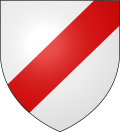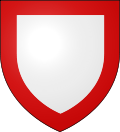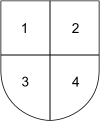Clan arms
A distinctive feature of Irish heraldry is acceptance of the idea of clan arms, which belong to descendants, not necessarily of a determinate individual, but of an Irish clan or sept, the chieftain of which, under Irish law, was not necessarily a son of the previous chieftain but could be any member of the clan whose grandfather had held the position of chieftain (tanistry). [1] A member of the particular clan has the right to display the arms of that clan, a right that on the contrary does not belong to people of the same surname who belong to a different sept. [2] For example, a person from the O'Kelly clan of Ui Máine may display the arms of that clan, but a Kelly of the Meath or Kilkenny clan cannot.
Proponents of English heraldry and those who hold a documented right to arms see clan arms as controversial, [2] but the Irish Genealogical Office (previously known as the Office of Arms) [3] "holds that any member of a clan may display the arms of that clan (as distinct from personally 'bearing' the arms, as on stationery, silver, or other such use, [for] only the grantee and his descendants may 'bear' the arms)". Edward McLysaght, the first Chief Herald of Ireland and the author of several works on Irish families, introduced this distinction. [4]
Pat Brennan writes that we simply do not have enough evidence to be doctrinaire about clan or sept arms. He adds: "Naturally the idea of clan or sept arms is anathema to English heraldic practice (like a lot of other Gaelic Irish customs)." However, to show that it is not totally unique, he cites H. Bedington & P. Gwynn-Jones, Heraldry (Greenwich, CT 1993): "In eastern Europe whole groups of families or territorial areas adopted the same armorial bearings (in) a form of clan affiliation." Brennan particularly points to heraldry in Poland, where arms may pertain to a whole group of families. In one extreme Polish case almost 600 families bear the same symbol - a horse-shoe enclosing a cross. [2]
Even after the introduction of English heraldry into Ireland and the setting up of arrangements for regulating it, the arms registered were undifferentiated, that is, they show no signs of the practice of changing a tincture or adding some symbol to personalize those of a particular individual. Brennan concludes that, rather than being the property of an individual, the arms belonged either to the sept as a whole or to the chief or to all members of the ruling elite in the sept. The hundreds of people claiming the right to arms indicate, Brennan says, either that they had used those arms for some time, or that the arms did not belong personally to the chief or that they were obviously based on the ancient clan system, so that the chief could not complain of their use by others. [2]
- The arms of the Butlers
- The arms of the FitzGeralds
- The arms of the FitzPatricks of Ossory
- The arms of the Kennedys
- The arms of the MacCarthy, king of Desmond and in earlier centuries, king of Munster.
- The arms of McGraths
- The arms of Magennis
- The arms of O'Donnell, king of Tyrconnell
- The arms of Nugent
- The arms of the O'Briens of Thomond
- The arms of The O'Higgins, Lord of Ballynary
- The arms of the O'Neill of Tyrone
- The arms of Purcell, Baron of Loughmore
- The arms of the O'Sullivan
- The arms of the O'Halloran Clan, ancient Lords of Galway
- The arms of the O'Flaherty




















































